WOLLASTON BRIDGE
OVER MERRI RIVER, WOLLASTON ROAD WARRNAMBOOL, WARRNAMBOOL CITY
-
Add to tour
You must log in to do that.
-
Share
-
Shortlist place
You must log in to do that.
- Download report


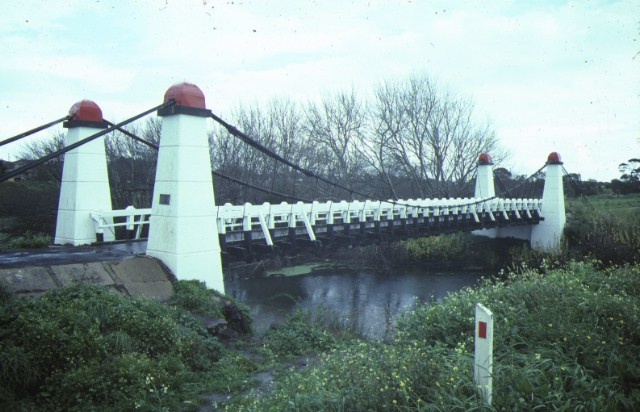
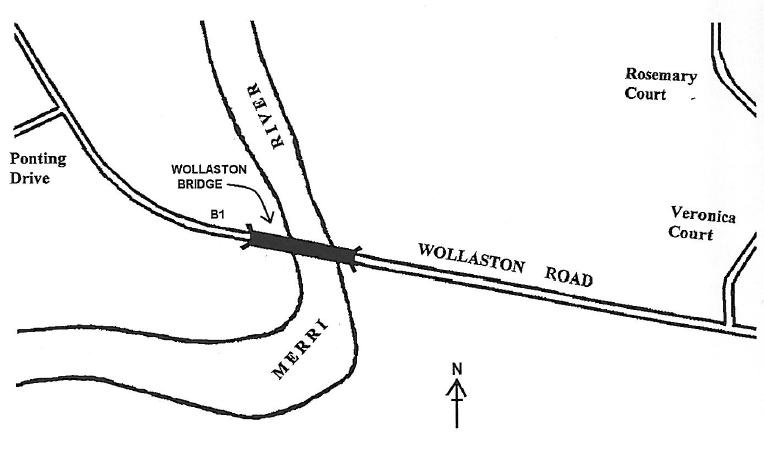
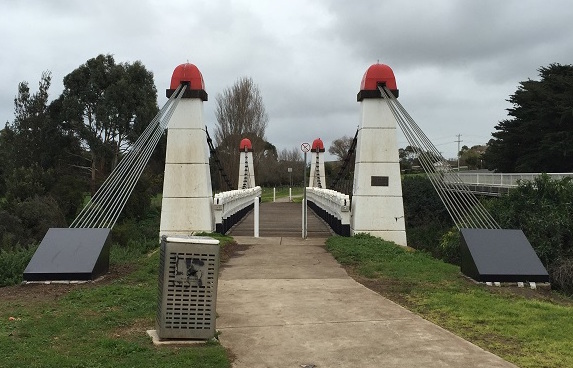
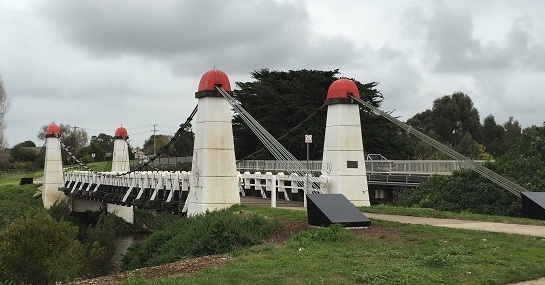
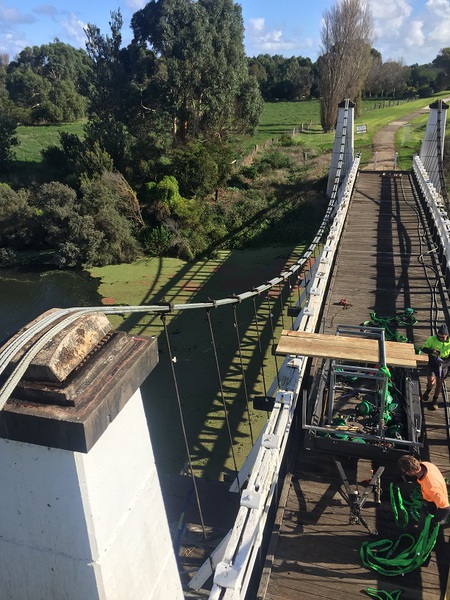


Statement of Significance
What is significant?
Wollaston Bridge at Warrnambool was erected across the Merri River in 1890 to facilitate access to the Wollaston Estate of Sir Walter Manifold. The design and construction of the bridge is attributed to Warrnambool contractor Arthur P. Dobson. In 1967 the Wollaston Bridge was by-passed by a new reinforced concrete structure located adjacent, and it is now used as a foot bridge. The Wollaston Bridge is a thirty metre long suspension bridge with a timber deck and superstructure suspended from steel cables anchored across four square tapered stone pillars to approach abutments. The pillars are constructed of stone and have cast iron caps with the steel cables passing over cast iron saddles within the pillars. The cables used in the suspension mechanism came from old Melbourne tram routes. The bridge has a timber balustrade independent of the structure.
How is it significant?
Wollaston Bridge is of architectural, aesthetic and historical importance to the state of Victoria
Why is it significant?
Wollaston Bridge is of architectural and aesthetic importance as an excellent and rare surviving example of a cable suspension bridge in Victoria. It is a sophisticated engineering structure of a substantial span and of notable aesthetic quality with its combination of materials including the stone pillars with cast iron capping, timber substructure and steel cables.
Wollaston Bridge is of social and historical importance for its associations with Sir Walter Manifold who payed for the bridge and who managed the Wollaston property from 1885 until the end of World War One when the property was divided up for soldier settlements. Sir Walter Manifold was elected to the Legislative Council for Western Province in 1908. When Sir John Davies retired as president of the council in 1919, Manifold was elected. Knighted in 1920 he presided until 1923 when ill health forced him to retire. Wollaston Bridge is a rare example of a substantial privately funded bridge.
-
-
WOLLASTON BRIDGE - History
Contextual History:
Sir Walter Synnot Manifold (Bede Nairn, Geoffrey Serle 1982. Vol. 10 p.390-39)
Walter Synnot Manifold, was born on 30 March 1849 at Grasmere, Warrnambool, Port Phillip District. He was the second son of Thomas Manifold and Jane Elizabeth, daughter of Captain Walter Synnot. He signed the roll as a solicitor in 1875 but did not practise. With his elder brother James, he bought Pine grove West Station, near Echuca. Bought Sesbiana in Queensland, entering into partnership with his uncle Peter Manifold and others. He managed Sesbiana in 1878-84, then sold out and returned to Warrnambool to take up his inheritance of Wollaston. On 23 April 1885 he married Fanny Maria, daughter of Commander Alexander Smith, R.N.
Manifold bred cattle at Wollaston, but turned most of the property over to dairy farming, run on a share and tenant basis. It left him time to devote to his favourite hobbies, cattle and machinery-by 1904 he had installed an electrical plant. After World War One, Wollaston was broken up for soldier settlement.
Walter was elected to the Legislative Council for Western Province in 1908. He was unofficial leader of the council in 1910-19. When Sir John Davies retired as president of the council in 1919, Manifold was elected. Knighted in 1920 he presided until 1923 when ill health forced him to retire. He resigned his seat in January 1924. A widower he died on 15 November 1928 at Toorak and was buried in St Kilda cemetery. His estate was sworn for probate at £83 356. Like his cousins at Purrumbete, Manifold had undertaken public work as a duty, imposed by his position as a leader of society and member of the pre-gold upper-class.
History of Place:
The Wollaston Bridge is one of the most important cable suspension bridges erected in Victoria in the nineteenth century. The bridge was privately funded by noted district pastoralist and Public figure, Sir Walter Manifold and has successfully withstood the ravages of successive floods since 1890 and survives as a sophisticated engineering structure of remarkable span. It replaced and earlier timber bridge in the same position (RNE Citation).
The Wollaston cable suspension bridge at Warrnambool was erected across the Merri River in 1890 to facilitate access to the Wollaston Estate of Sir Walter Manifold. It carried Wollaston Road over the Merri River Warrnambool. The design and construction of this bridge, which consists of a timber deck and superstructure suspended from steel cables anchored across square tapered stone towers to approach abutments, is attributed to Warrnambool contractor Arthur P. Dobson (RNE Citation).
Its designer and builder Arthur Dobson was also responsible for designing the Warrnambool breakwater (Warrnambool Standard April 12, 1985 p.1).
In 1966, the bridge was considered unsafe for traffic and was handed over to the National Trust in June, 1968. In 1967 the Wollaston Bridge was replaced by a new reinforced concrete structure located adjacent (Warrnambool Standard April 12, 1985 p.1).
In 1985 cables were replaced on the bridge after the original cables collapsed (Warrnambool Standard April 12, 1985 p.1).
Associated People: Assoc.People SIR WALTER MANIFOLDWOLLASTON BRIDGE - Assessment Against Criteria
Criterion A
The historical importance, association with or relationship to Victoria's history of the place or object.
Criterion B
The importance of a place or object in demonstrating rarity or uniqueness.
Wollaston Bridge is a rare example of a small suspension bridge which was privately funded. It is a rare example of a cable suspension bridge in Victoria.
Criterion C
The place or object's potential to educate, illustrate or provide further scientific investigation in relation to Victoria's cultural heritage.
Criterion D
The importance of a place or object in exhibiting the principal characteristics or the representative nature of a place or object as part of a class or type of places or objects.
Wollaston bridge is representative of engineering methods of the time and is an excellent example of a suspension bridge. It is a sophisticated engineering structure of a substantial span (30m).
Criterion E
The importance of the place or object in exhibiting good design or aesthetic characteristics and/or in exhibiting a richness, diversity or unusual integration of features.
Wollaston bridge is an attractive landmark in the pastoral landscape. It is unusual for its use of former tram cables in its construction. It has a notable aesthetic quality with its combination of materials including the stone columns cast iron capping, timber substructure and steel cables.
Criterion F
The importance of the place or object in demonstrating or being associated with scientific or technical innovations or achievements.
Criterion G
The importance of the place or object in demonstrating social or cultural associations.
Wollaston Bridge is important for its associations with district pastoralist and public figure Sir Walter Manifold. The bridge is also important for its associations with its designer and builder Arthur Dobson was also responsible for designing the Warrnambool breakwater.
Criterion H
Any other matter which the Council considers relevant to the determination of cultural heritage significanceWOLLASTON BRIDGE - Permit Exemptions
General Exemptions:General exemptions apply to all places and objects included in the Victorian Heritage Register (VHR). General exemptions have been designed to allow everyday activities, maintenance and changes to your property, which don’t harm its cultural heritage significance, to proceed without the need to obtain approvals under the Heritage Act 2017.Places of worship: In some circumstances, you can alter a place of worship to accommodate religious practices without a permit, but you must notify the Executive Director of Heritage Victoria before you start the works or activities at least 20 business days before the works or activities are to commence.Subdivision/consolidation: Permit exemptions exist for some subdivisions and consolidations. If the subdivision or consolidation is in accordance with a planning permit granted under Part 4 of the Planning and Environment Act 1987 and the application for the planning permit was referred to the Executive Director of Heritage Victoria as a determining referral authority, a permit is not required.Specific exemptions may also apply to your registered place or object. If applicable, these are listed below. Specific exemptions are tailored to the conservation and management needs of an individual registered place or object and set out works and activities that are exempt from the requirements of a permit. Specific exemptions prevail if they conflict with general exemptions. Find out more about heritage permit exemptions here.Specific Exemptions:
General Conditions:
1. All alterations are to be planned and carried out in a manner which prevents damage to the fabric of the registered place or object.
2. Should it become apparent during further inspection or the carrying out of alterations that original or previously hidden or inaccessible details of the place or object are revealed which relate to the significance of the place or object, then the exemption covering such alteration shall cease and the Executive Director shall be notified as soon as possible.
3. If there is a conservation policy and plan approved by the Executive Director, all works shall be in accordance with it.
4. Nothing in this declaration prevents the Executive Director from amending or rescinding all or any of the permit exemptions.
5. Nothing in this declaration exempts owners or their agents from the responsibility to seek relevant planning or building permits from the responsible authority where applicable.
* No permit required for routine maintenance of the Wollaston Bridge
* No permit required to replace like with like on the Wollaston Bridge
-
-
-
-
-
WOLLASTON BRIDGE
 Victorian Heritage Register H1453
Victorian Heritage Register H1453 -
Wollaston Suspension Bridge
 National Trust H1453
National Trust H1453 -
EUCALYPTUS NICHOLII
 National Trust
National Trust
-
"1890"
 Yarra City
Yarra City -
'BRAESIDE'
 Boroondara City
Boroondara City -
'ELAINE'
 Boroondara City
Boroondara City
-
-












